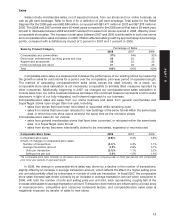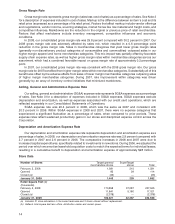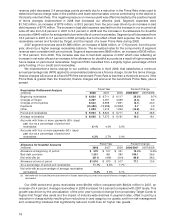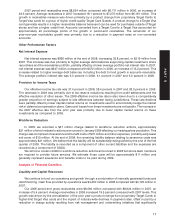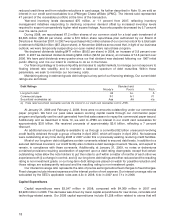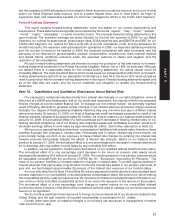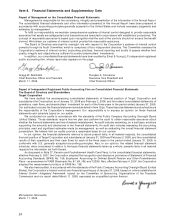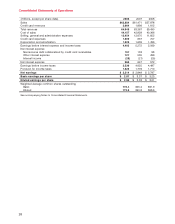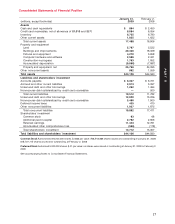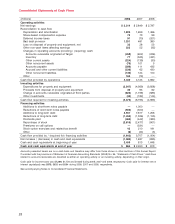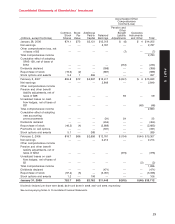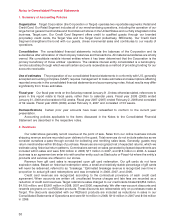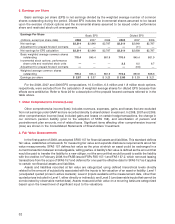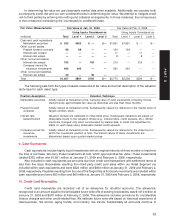Target 2008 Annual Report Download - page 43
Download and view the complete annual report
Please find page 43 of the 2008 Target annual report below. You can navigate through the pages in the report by either clicking on the pages listed below, or by using the keyword search tool below to find specific information within the annual report.
last two quarters of 2009 will depend on the extent to which economic conditions improve, and in turn to what
extent our Retail Segment sales improve, and to a lesser degree when, and to what extent, we begin to
experience clear and measurable benefits of recent risk management efforts in the Credit Card Segment.
This report contains forward-looking statements, which are based on our current assumptions and
expectations. These statements are typically accompanied by the words ‘‘expect,’’ ‘‘may,’’ ‘‘could,’’ ‘‘believe,’’
‘‘would,’’ ‘‘might,’’ ‘‘anticipates,’’ or words of similar import. The principal forward-looking statements in this
report include: The expected earnings per share (diluted) for the first two quarters of 2009; for our Retail
Segment, our outlook for sales trends, gross margin rates, SG&A expense rate, and EBITDA and EBIT; for our
Credit Card Segment, our outlook for future write-offs of current receivables, profit, and the allowance for
doubtful accounts; the expected cash generated from operations in 2009; our expected capital expenditures
and the number of stores to be opened in 2009; the expected compliance with debt covenants; and the
adequacy of our reserves for general liability, workers’ compensation, property loss, team member medical
and dental claims, workforce reduction costs, the expected outcome of claims and litigation and the
resolution of tax uncertainties.
All such forward-looking statements are intended to enjoy the protection of the safe harbor for forward-
looking statements contained in the Private Securities Litigation Reform Act of 1995, as amended. Although
we believe there is a reasonable basis for the forward-looking statements, our actual results could be
materially different. The most important factors which could cause our actual results to differ from our forward-
looking statements are set forth on our description of risk factors in Item 1A to this Form 10-K, which should be
read in conjunction with the forward-looking statements in this report. Forward-looking statements speak only
as of the date they are made, and we do not undertake any obligation to update any forward-looking
statement.
Item 7A. Quantitative and Qualitative Disclosures About Market Risk
Our exposure to market risk results primarily from interest rate changes on our debt obligations, some of
which are at a LIBOR-plus floating rate, and on our credit card receivables, the majority of which are assessed
finance charges at a prime-based floating rate. To manage our net interest margin, we generally maintain
levels of floating-rate debt to generate similar changes in net interest expense as finance charge revenues
fluctuate. Our degree of floating asset and liability matching may vary over time and vary in different interest
rate environments. At January 31, 2009, our level of floating-rate credit card assets exceeded our level of net
floating-rate debt obligations by approximately $1.3 billion. As a result, based on our balance sheet position at
January 31, 2009, the annualized effect of a half percentage point decrease in floating interest rates on our
floating rate debt obligations, net of our floating rate credit card assets and marketable securities, would be to
decrease earnings before income taxes by approximately $7 million. See further description in Note 20.
We record our general liability and workers’ compensation liabilities at net present value; therefore, these
liabilities fluctuate with changes in interest rates. Periodically and in certain interest rate environments, we
economically hedge a portion of our exposure to these interest rate changes by entering into interest rate
forward contracts that partially mitigate the effects of interest rate changes. Based on our balance sheet
position at January 31, 2009, the annualized effect of a one percentage point decrease in interest rates would
be to decrease earnings before income taxes by approximately $19 million.
In addition, we are exposed to market return fluctuations on our qualified defined benefit pension plans.
The annualized effect of a one percentage point decrease in the return on pension plan assets would
decrease plan assets by $18 million at January 31, 2009. The resulting impact on net pension expense would
be calculated consistent with the provisions of SFAS No. 87, ‘‘Employers’ Accounting for Pensions.’’ The
value of our pension liabilities is inversely related to changes in interest rates. To protect against declines in
interest rates we hold high-quality, long-duration bonds and interest rate swaps in our pension plan trust. At
year end, we had hedged approximately 50 percent of the interest rate exposure of our funded status.
As more fully described in Note 14 and Note 26, we are exposed to market returns on accumulated team
member balances in our nonqualified, unfunded deferred compensation plans. We control our risk of offering
the nonqualified plans by making investments in life insurance contracts and prepaid forward contracts on our
own common stock that offset a substantial portion of our economic exposure to the returns on these plans.
The annualized effect of a one percentage point change in market returns on our nonqualified defined
contribution plans (inclusive of the effect of the investment vehicles used to manage our economic exposure)
would not be significant.
We do not have significant direct exposure to foreign currency rates as all of our stores are located in the
United States, and the vast majority of imported merchandise is purchased in U.S. dollars.
Overall, there have been no material changes in our primary risk exposures or management of market
risks since the prior year.
23
PART II
Forward-Looking Statements


